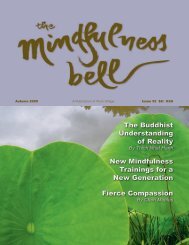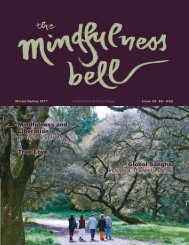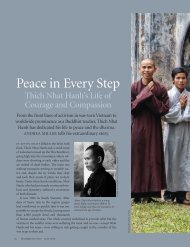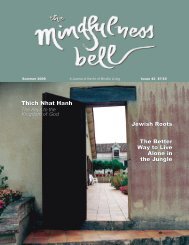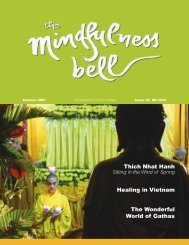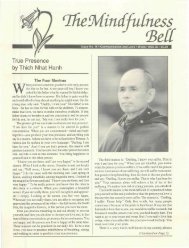Download - The Mindfulness Bell
Download - The Mindfulness Bell
Download - The Mindfulness Bell
You also want an ePaper? Increase the reach of your titles
YUMPU automatically turns print PDFs into web optimized ePapers that Google loves.
ook REVIEWS<br />
and Eve Merriam are among non-Buddhist westerners<br />
selected by Gach whose poems greet us with zen haiku<br />
and the reality of impermanence, respectively.<br />
Allen Ginsberg says what this book means: “<strong>The</strong> whole<br />
body of the One Thus Come/falls in the raindrops and<br />
drips from the eaves.” Thich Nhat Hanh’s well-loved<br />
prose poem, “Interbeing,” excerpted from <strong>The</strong> Heart<br />
of the Buddha’s Teachings, says what this book means:<br />
“If you are a poet, you will see a cloud in this piece of<br />
paper.” <strong>The</strong>se are poems that allow us to transcend them.<br />
“As thin as this sheet of paper is, it contains everything<br />
in the universe....”<br />
Of special note is the “Visible Language” section, a short<br />
but sweet exhibit of calligraphy, altar (shape) poems and<br />
brush drawings, including work by Thich Nhat Hanh, Peter<br />
Bailey, Shunryu Suzuki, and my old favorite Paul Reps,<br />
among others. One of Reps’ drawings shows a Buddha in<br />
brush strokes with a straight, ruled line down the center of<br />
his head and body. “Open Here,” is the inscription below.<br />
I heartily recommend to students of the Buddha to Open<br />
this book Here.<br />
And of note...<br />
By Judith Toy<br />
Worlds in Harmony: Compassionate Action for a Better<br />
World, by His Holiness the Dalai Lama, Parallax Press,<br />
46 Winter/Spring 2009<br />
2008, softbound, 108 pages, abridged from three days<br />
of dialogue between His Holiness and seven renowned<br />
helping professionals at the Harmonia Mundi conference<br />
in Newport Beach California, October, 1989. In his<br />
foreword, Daniel Goleman, Ph.D., author of Emotional<br />
Intelligence, reminds us that those of us alive now are the<br />
first generation in human history to glimpse the possibility<br />
of the end of our world. From the premise that this insight<br />
is of no use unless it results in action, His Holiness speaks<br />
with us person to person to teach us precisely how to save<br />
ourselves and the planet through compassion and loving<br />
kindness. He teaches us to be, think, and act as citizens<br />
of the world in ways that are based on equanimity and<br />
understanding. This book is also a guide to the practice<br />
of healing and compassionate action in daily life.<br />
Hope Is An Open Heart, by Lauren Thompson, Scholastic<br />
Press, 2008, hardcover, 32 pages, illustrated by various<br />
photographers; a children’s picture book. Lauren Thompson<br />
practices with Rock Blossom Sangha in Brooklyn,<br />
New York, part of the New York Metro Community of<br />
Mindful Living. She is a best-selling, award-winning<br />
children’s author. This book is dedicated to her Rock<br />
Blossom sister Alison who died at age 42 of brain cancer.<br />
<strong>The</strong> author wrote to me, “Though she was not ready to<br />
die, and had little reason to hope for a future at all, she<br />
found the most peace by focusing on the joy of the present<br />
moment.” This gorgeously illustrated book of few<br />
words invites its readers into the beauty and wonder of<br />
the present moment.<br />
<strong>The</strong> Complete Idiot’s Guide to Understanding Buddhism,<br />
Second Edition, by Gary Gach, Alpha, 2004, softbound,<br />
390 pages. In a light-hearted voice, this chock-full compendium<br />
presents the life and teachings of the Buddha<br />
and explains how they spread and adapted to different<br />
cultures. It includes an introduction to meditation and explanations<br />
of the Three Jewels, the Four Noble Truths, and<br />
the Eightfold Path. Gach, a student of Thich Nhat Hanh,<br />
also includes insights into Buddhism’s cross-religious<br />
influences and a chronology of Buddhist history. Most<br />
important is the Buddhist perspective on why we suffer<br />
and what we can do to be free. As Thich Nhat Hanh says<br />
about this book, “It will bring a smile to us all.”<br />
<strong>The</strong> Plum Village Cook Book, by monks and nuns of<br />
Plum Village, Thich Nhat Hanh’s monastery in Southern<br />
France, published by Plum Village, 2008, softbound, 66<br />
pages; illustrated with full-color photographs. In this little<br />
kitchen treasure, readers are invited to visit Plum Village<br />
to see firsthand how the brothers and sisters “cook vegetarian<br />
food mindfully, joyfully and calmly, which might<br />
be an inspiration for you.” Most of the ingredients used<br />
in these all-veggie recipes can be found at your local<br />
[American] grocer; some items such as black and white<br />
fungus, veggie ham, and veggie fish can be found at an<br />
Asian market or online. Recipes use the European metric<br />
system, so some cooks may need a U.S.-to-metric conversion<br />
table. But it’s well worth it to experiment with these<br />
tasty dishes that many of us have enjoyed at Thich Nhat<br />
Hanh’s monasteries.



